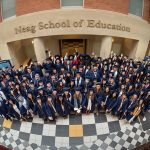Are charter schools like polluting industries? That’s a provocative analogy, but two University of Connecticut researchers explore it in a recent paper. They contend that, while some charter schools may help students, the sector needs stronger regulation to prevent harm to students and school districts. “I would argue that, even if there are benefits, that does not give you carte blanche to not regulate or mitigate the harms that occur,” Preston C. Green III, the paper’s lead author, told me.
For more than 50 years, the University of Connecticut Alumni Faculty Excellence Awards have served as an opportunity to recognize the outstanding contributions and achievements of the University’s faculty members to the institution, their current and former students, and their respective areas of academic discipline.
A Milford resident, Melillo has served as the assistant superintendent of curriculum and instruction for Hamden Public Schools since July 2012. During that time he also served as interim superintendent of schools, from February to July 2014. He served as Hamden’s director of elementary education, October 2010-June 2012; principal at Shepherd Glen School, also in Hamden, July 2007-October 2010; and as assistant principal at ACES-Thomas Edison Middle School in Meriden, August 2005-June 2007. He began his career as a fifth to sixth grade teacher at Church Street School and Bear Path School in Hamden, August 1993-June 2005. Melillo earned his Bachelor of Science degree in Education at the University of Connecticut, graduating in May 1991.
On Thursday, May 12, 2022, the University of Connecticut Office of Global Affairs commemorated the 30th Anniversary of the Baden-Württemberg – Connecticut Partnership at UConn Avery Point campus’ Branford House honoring a visiting delegation led by Theresia Bauer, Baden-Württemberg Minister for Science, Research and Arts, and consisting of representatives from UConn’s partner institutions of higher education within that state in Germany.
Hoeft also created the “B.R.A.I.N. Camp” reading intervention program with Devin Kearns, a professor of educational psychology in the Neag School of Education; and the highly successful “Ask a Brain Scientist” online series of hands-on science classwork used by hundreds of children registered from around Connecticut and elsewhere in the U.S.
Throughout the academic year, the Neag School is proud to share the latest achievements of its faculty, staff, students, and alumni. Explore their most recent promotions, awards, retirements, publications, and more: Dean’s Office Department of Curriculum and Instruction and Teacher Education Department of Educational Leadership Department of Educational Psychology Faculty/Staff Students Alumni In Memoriam Dean’s […]
6th Grade English and Language Arts Teacher April Wilson is the 2023 Teacher of the Year for East Hartford Public Schools. District leaders surprised Ms. Wilson with the news in her East Hartford Middle School classroom on May 18. She was selected after a rigorous application and interview process, during which Wilson completed a virtual interview on her wedding day! She will represent the school district as an example of what is best in the profession in the statewide Teacher of the Year competition. A graduate of East Hartford Public Schools herself, Wilson earned her Master’s degree at UConn’s Neag School of Education in 2018 then returned to her hometown of East Hartford to teach.
arah R. Luria, a Ph.D. candidate in Neag School of Education’s Educational Psychology program, has been selected as one of 100 recipients of the $20,000 Scholar Award from the Philanthropic Educational Organization (P.E.O.) Sisterhood.
Sally Reis, the Leticia Morgan Chair in Educational Psychology at the Neag School of Education, first connected to the University of Connecticut during her master’s program at Southern Connecticut State University in the mid-1970s. While in one class, she heard UConn Board of Trustees Distinguished Professor Joseph Renzulli talk about his work in educational psychology, specifically his internationally-known and pioneering work in gifted and talented with the Enrichment Triad Model.
For several years I also worked with Alan Marcus at the Neag School of Education on Teaching American History grants to give intense annual teacher training on how to bring Connecticut history into the classroom. As part of that we got involved with the State Board of Education’s revision of the state curriculum. I am proud to say they incorporated into the last round of the frameworks a quasi-requirement that when you teach American history in Connecticut you use as many examples as possible from Connecticut history to tell those stories. That I feel is a kind of a victory.


